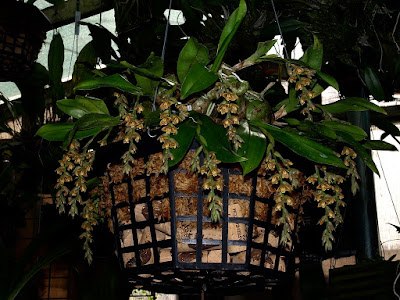Polystachya affinis is found in Benin, Ghana, Guinea, Ivory Coast, Liberia, Nigeria, Sierra Leone, Togo, Cameroon, Congo, Central African Republic, Equatorial Guinea, Gulf of Guinea Islands, Zaire, Angola and Uganda. It grow in evergreen forests at 600-1350 m.
Polystachya affinis also called as The Similar Polystachya, Chelystachya affinis, Dendrorkis affinis, Dendrorkis bracteosa, Polystachya bracteosa, Polystachya villosa, Polystachya villosula, is a species of the genus Polystachya. This species was described by John Lindley in 1830.
IDENTIFY POLYSTACHYA AFFINIS ORCHID PLANT
Polystachya affinis is found in Benin, Ghana, Guinea, Ivory Coast, Liberia, Nigeria, Sierra Leone, Togo, Cameroon, Congo, Central African Republic, Equatorial Guinea, Gulf of Guinea Islands, Zaire, Angola and Uganda. It grow in evergreen forests at 600-1350 m.
It is a small sized, 15-50 cm tall, hot to cool growing epiphyte with round, compressed, almost coin-like, flat on substrate, single noded pseudobulb carrying 2 to 3, broadly oblanceolate to oblong, petiolate, 8-28 cm long, 2.6-6 cm wide leaves.
The Similar Polystachya blooms in the late winter on an arching to sharply pendulous, pilose, loosely many flowered, to 40 cm long inflorescence with scented, pubescent flowers. The flowers are medium-sized, fragrant, densely pubescent, the sepals pale brown to yellow or mustard yellow washed with green and yellow with pale red purplish markings, the petals and the lip yellow, the veins purple.
POLYSTACHYA AFFINIS ORCHID PLANT CARE AND CULTURE
Cultural information should only be used as a guide, and should be to be adapted to suit you. Your physical location; where you grow your plants, how much time you have to devote to their care, and many other factors, will need to be taken into account. Only then can you decide on the cultural methods that best suit you and your plants.
Light:
Polystachya affinis needs a light level of 18000-25000 lux. Light should be filtered or diffused, and plants should not be exposed to direct midday sun. Strong air movement should be provided at all times.
Temperature:
Summer days temperature at average 26-27°C, and nights temperature at average 17°C, with a diurnal range of 10°C.
Humidity:
The Similar Polystachya need the humidity of 80-85% most of the year, dropping to near 75% for about 2 months in late winter and early spring.
Substrate, growing media and repotting:
Polystachya affinis usually are grown in relatively small hanging pots or baskets filled with an open, fast-draining medium that retains some moisture after watering. The medium should dry out between waterings, however. The standard fir-bark mixes work well for many growers.
Plants may also be mounted tightly to a tree-fern slab. If mounted, however, high humidity must be maintained and the plants watered at least once daily in summer. Several waterings a day may be necessary for mounted plants during extremely hot, dry weather.
Most Polystachya species appear to grow better when allowed to form large clumps, so they should be divided as little as possible. Repotting, mounting, or dividing should be done only when new root growth is just starting. This allows the plant to become established in the shortest possible time with the least amount of stress.
Watering:
Rainfall in the habitat is heavy most of the year, with 2-3 rather dry months in winter. Cultivated plants should be watered heavily while actively growing. Water should be reduced somewhat in late autumn.
Fertilizer:
1/4-1/2 recommended strength, applied weekly when plants are actively growing. You can use a balanced fertilizer throughout the year; but also can use a high-nitrogen fertilizer from spring to midsummer, then switch to one high in phosphates in late summer and autumn.
Rest period:
Winter days temperature at average 24-25°C, and nights average 14-16°C, with a diurnal range of 10°C. Polystachya affinis need less in winter, but they should never remain completely dry for long periods. Occasional to somewhat regular early-morning mistings between infrequent light waterings should provide sufficient moisture in most growing areas. Fertilizer should be reduced or eliminated when water is reduced.















COMMENTS